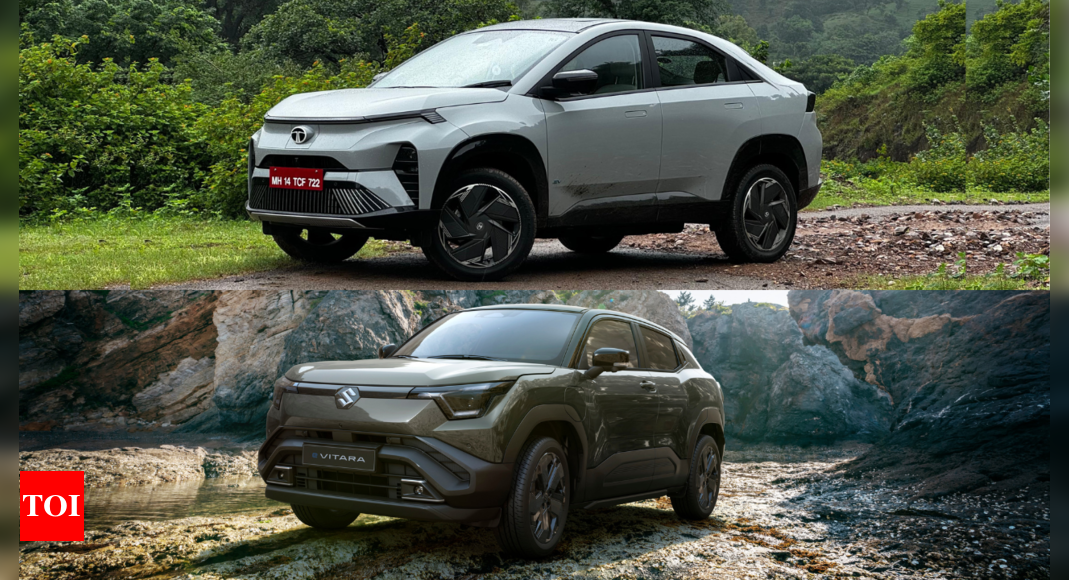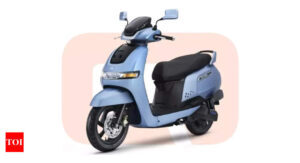[ad_1]

Japanese Automaker Suzuki revealed the new e-Vitara SUV globally. The e-Vitara is essentially the production version of the eVX concept which was showcased at the Delhi Auto Expo last year. The e-Vitara will make its India debut at the upcoming 2025 Bharat Mobility expo and will be launched in India in March 2025. It will be produced at the Maruti’s Gujarat plant and will also be sold under the Toyota brand. The e-Vitara will be the first electric vehicle from Maruti Suzuki in India and will compete with the Tata Curvv EV, MG ZS EV and the upcoming Hyundai Creta EV and Mahindra BE 05 when launched in the Indian market. In this article, let’s compare the new e-Vitara with the Tata Curvv EV with all available details.
Maruti Suzuki e-Vitara vs Tata Curvv EV: Variants and pricing
Comparing the pricing and variants first, the Curvv EV SUV is offered in five main variants and two battery pack options – 45 kWh and 55 kWh. The 45 kWh version is available with Creative priced at 17.49 lakh, Accomplished Rs 18.49 lakh and Accomplished plus S at Rs 19.29 lakh. The 55 kWh version is available with Accomplished priced at Rs 19.25 lakh, Accomplished Plus S at 20 lakh, Empowered Plus at 21.25 lakh and Empowered Plus S priced at Rs 22 lakh (all prices are ex-showroom).

There are no details regarding the pricing or variants but it will be offered with two battery pack options with expected prices starting from Rs 20 lakh and going close to Rs 30 lakh for the AWD version with a bigger battery pack ( all prices ex-showroom).
Maruti Suzuki e-Vitara vs Tata Curvv EV: Dimensions
Before comparing the dimensions, let’s talk about the design of e-Vitara. The e-Vitara looks very similar to the eVX concept and packs in a muscular design. At the front, it features tri-LED daytime running lights with a closed-off grille. The lower bumper looks similar to the Brezza and houses a small fog lamp with skid plates. The charging port is placed on the front flanks, and it has a prominent bulge over the rear wheel arch. At the sides, it gets aerodynamically designed alloy wheels which likely measure 18 inches and the rear door handle is placed on the C-pillar.

In terms of dimensions, the e-Vitara measures 4,275mm in length, 1,800mm in width, 1,635mm in height and has a generous 2,700mm wheelbase. It has 180mm ground clearance and has a kerb weight of up to 1,900 kgs. The Curvv EV measures 4310 mm in length, 1810 mm in width, 1637 mm in height, 2560 mm of wheelbase, 190 mm of ground clearance and gets boot space of 500 litres. The Curvv EV has more length, more height, more width whereas the e-Vitara has more wheelbase.
Maruti Suzuki e-Vitara vs Tata Curvv EV: Features
The company has not revealed the feature list of the e-Vitara yet. The interior of the e-Vitara looks completely fresh and doesn’t look similar to any other Suzuki products globally. It features floating dual screens for the instrument cluster and the infotainment screen, it also gets a floating centre console finished in gloss black which packs in controls for gear selection, e-brake, and drive mode selection and also has a wireless charging pad. Other highlights include a two-spoke steering wheel, rectangular AC vents with their brushed silver surrounds, rotary drive state selector and leatherette upholstery.

In terms of features, the Curvv EV gets a 12.3-inch floating infotainment touchscreen, a 320W 9-speaker JBL sound system, a panoramic sunroof, a 10.25-inch digital instrument cluster, four-spoke steering with illuminated Tata logo and paddle shifters to adjust re-gen, wireless charging pad, ventilated and six-way adjustable front seats, a two-step rear seat recline function, cooled glove box, 45W Type-C charging ports, connected car tech, Arcade. Ev app suite, powered tailgate with gesture control, push-button start and much more.
Safety features include six airbags, ESP, all-wheel disc brakes, and a range of other features. Additionally, it includes acoustic alerts to ensure pedestrian safety and Level 2 ADAS with 20 features.

Maruti Suzuki e-Vitara vs Tata Curvv EV: Battery and range
Now let’s talk about the battery, e-motor and range. The Curvv EV is available in two battery pack options – a 45 kWh with a 502 km range and 55 kWh with 585 km (both claimed). In real-world conditions, these provide an estimated range of up to 350 km and 425 km, respectively. The EV also features a 1.2C charging rate, allowing it to achieve a range of 150 km in just 15 minutes of charging. Both battery packs come paired with a single PMSM electric motor which puts out 167 hp of power with the ability to sprint from 0-100 kph in 8.6 seconds and a top speed of 160 kph. (claimed).
New Maruti Suzuki Dzire Review: Best Dzire Ever! | TOI Auto
The Suzuki e-Vitara is built on the Heartect-e skateboard platform and is jointly developed by Suzuki and Toyota. The company claims that it merges the characteristics of a battery electric vehicle (BEV) with the durability of an SUV. The EV features eAxles, which integrate the motor and inverter into a single unit. The e Vitara will be offered with two battery options – 49kWh and 61kWh. The batteries use LFP (Lithium Iron-phosphate) ‘blade’ cells sourced by BYD and the larger 61kWh is expected to have a range of up to 550 km in one full charge.
The 49kWh battery will come paired with a single motor placed on the front axle which puts out 144hp. The bigger 61kWh battery also gets single-motor but here it puts out 174hp. Both motors produce identical 189Nm of torque which is surprisingly low compared to other electric SUVs in the market. There’s also an AWD version offered with a dual motor setup, placed one on each axle and this puts out 184hp and 300Nm torque. Suzuki calls the AWD tech in e-Vitara e-AllGrip, it features a Trail mode that engages the brakes on wheels lacking traction while directing torque to the wheels with grip. This system effectively simulates a limited-slip differential.
[ad_2]



